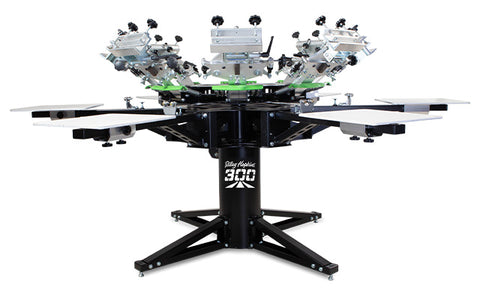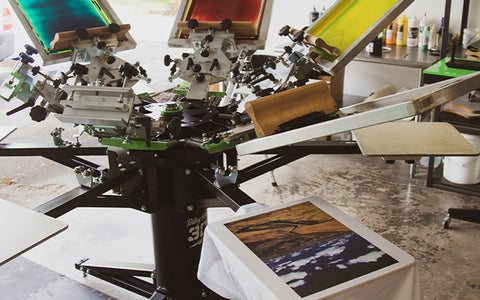Ready to step up your screen printing game? Whether you’re printing in a spare room, garage, or commercial space, a press upgrade can jumpstart your shop. Beginner presses like the Riley Hopkins 150 are perfect for learning the ropes. But eventually, you may find yourself wanting more printheads, stations, and upgraded manual press technology. There are two options in the Riley Hopkins press line: the 250 and 300. Which is best for you? Let’s break it down.

RILEY HOPKINS 250
The Riley Hopkins 250 press is a staple for many print shops. Its tabletop design makes it more portable than the large 300, and it can sit on top of a press cart, cabinet, or any other surface you’d like to print on. The 250 comes in sizes from 4 colors & 1 station to 6 colors & 4 stations. This means printers can reach similar print productivity as 300 press without sacrificing space. At a lower price point than the Riley 300, it’s the perfect option for printers looking to upgrade without breaking the bank.
We mentioned the 250 is a tabletop press. The term “tabletop” doesn’t mean the press has sacrificed any quality. Engineered to stand the test of time, the 250 is sturdy and capable of breaking your shop out from the pack. Mount the press on a press cart or other surface to create a complete screen printing station. The best part? A press cart with casters can be moved out of the way, so you can create the perfect shop setup.
So the press is sturdy and can hold up to 6 screens. Every print head is also equipped with XY micro-registration, making registering prints super easy. Simply turn the knobs to adjust the screen instead of loosening the screen and tapping it into place. Printers can also add the laser guiding system to their 250 press for extra print location precision.
RELATED: RILEY HOPKINS PRESSES: SCREEN PRINTING EQUIPMENT BUILT LIKE RACE CARS

RILEY HOPKINS 300
Printers looking to fire on all cylinders will benefit from an upgrade to the Riley Hopkins 300. This press is built to handle complicated jobs, long jobs, detailed jobs, rush jobs, and more. Imagine what 6 platen arms will do for your shop. Big job with more than 300 pieces? Bring it on. The 300 press comes in configurations from 4 colors & 4 stations to 8 colors & 6 stations. Don’t worry about sending jobs away because they’ll require 8 screens.
With a bigger press comes a bigger footprint. A Riley 300 can fit in a two-car garage (and make the whole shop look epic). Many printers are interested in printing full-time move to commercial shops that provide more space, commercial outlets with increased voltage, and extra visibility to their business. The free-standing press not only looks like a beast in a shop but prints like one too.
Insider Note: The Riley 300 is built so tough it can withstand a hurricane. Printers affected by severe weather report that their 300 presses are literally holding up the roof of their shop, with only minor damage.
The 300 comes standard with XYZ micros, a step up from the 250 and its XY micros. The Z micro controls off-contact. This means printers can change off-contact with the turn of one knob without having to re-adjust their registration. Say you have a job that requires hoodies and t-shirts printed with the same design. Instead of manually adjusting the off-contact between those two garments, you’ll be able to do it with the turn of a knob and get back to printing.
Wait, there’s more. Customizing your press to work for you is one of the best features of the Riley 300. Add a laser guiding system to the press for better placement precision. Side clamps also improve printing efficiency on the 300. These clamps attach to the print head and help to further stabilize the arm and screen flex you get when pulling a squeegee, which forces the screen into contact with the platen. The side clamps help to stabilize the screen and keep it from dipping forward as much.
RELATED: SHIFT YOUR SHOP INTO OVERDRIVE WITH THE RILEY HOPKINS 300 PRESS

WHICH IS BEST FOR YOU?
Now you know what each press is capable of. But which is better for your shop? Let’s talk about which press is best for different types of printers and shops.
RELATED: THE RILEY HOPKINS COMPARISON CHART
SIDE HUSTLERS
Printing in a smaller space? Screen printing as a side hustle, and looking to make it full-time? The Riley Hopkins 250 is a great press for printers mastering the trade and looking to get into new avenues of screen printing.
With a lower price point, the press boasts tons of capability. You can start printing designs up to 6 colors, learn the ins and outs of your new press, and start making screen printing your full-time gig. Many shops invest in a larger 250 and keep it until they size up to an automatic screen printing press. With up to 6 colors and 4 print arms, it’s a press that’ll keep up with demand.
FULL-TIME PRINTERS
Screen printers wanting their press to work harder than they do will benefit from a Riley Hopkins 300 press. With tons of color and print heads, pulling a squeegee will feel like a dream.
The 300 needs a larger space and comes in at a higher price point than the 250. However, this manual screen printing press can print whatever your customers throw at it.
RELATED: HOW TO CHOOSE THE RIGHT MANUAL SCREEN PRINTING MACHINE FOR YOUR SHOP

No matter which presses you decide to get, you’ll invest in quality, American-made craftsmanship that doesn’t cut corners. Riley Hopkins presses are hand-crafted for quality, longevity, and badassery. Choose the press that fits your process, shop, and plans for the future to surge to the finish line.

